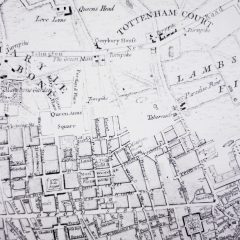https://news.fitzrovia.org.uk/category/history/
Fitzrovia’s history is closely connected with radicalism. Like Clerkenwell, a mile or so to its east, Fitzrovia had an anarchic, insurrectionary spirit that flourished in the decades before and after 1900. Its lodgings, café’s and working-men’s clubs were often scenes of intense political discussion and, occasionally, outbreaks of violent revolt.
The police and the government worked hard to suppress radicalism in Britain’s cities, and were largely successful after 1900. But, on 1 July 1909, Indian nationalism led to perhaps the most momentous occurrence of this period that was also linked to Fitzrovia: the fatal shooting by Madan Lal Dhingra of Sir William Curzon Wyllie, the aide-de-camp to Lord Morley who was the Secretary of State for India. This political assassination involved an unlikely-sounding location in Tottenham Court Road: Fairyland, a penny arcade owned by Henry Stanton Morley (no relation to Lord Morley!). Besides offering coin-in-the-slot machines to passing customers, Fairyland had an upstairs shooting gallery which served as a practice venue for Dhingra and other nationalists for some weeks before the assassination and on the day. Anarchists may also have played a role: one of the guns found on Dhingra was believed to have been supplied by anarchist sources in Paris.
Madan Lal Dhingra was a student of engineering at University College, situated close to Tottenham Court Road in Gower Street. He had arrived in London in 1906 and became a fervent Indian nationalist under the influence of V.D. Savarkar, a leading member of the Highgate-based India House set who advocated the violent overthrow of British rule in India. British reprisals in India for revolutionary activities, such as the execution of Khudi Ram for bomb-throwing in 1908, fed a narrative of patriots making sacrifices for a free motherland, and increased the desire among nationalists to retaliate in Britain. A Dr. Desai lectured on “The Making of Bombs” at India House in June 1908; and The Indian Sociologist, edited and published by Shyamji Krishnavarma who had established India House in 1905, also advocated the use of violence for political ends. By April 1909 anti-British feeling was running extremely high at India House. Dhingra, who had been living there, was asked by his parents, who were well-connected and knew Lord Wyllie, to move somewhere else. He moved, but remained very closely attached to Savarkar and the others at the House.
After practising shooting at Fairyland on 1 July, Dhingra attended the National Indian Association’s evening gathering at Imperial College at which official guests were present. At around 11pm when guests were leaving he fired four shots at Wyllie’s face and head, also unintentionally shooting a Dr. Lalcaca who had tried to help Wyllie and who later died from his injuries. It was reported that Dhingra was urged to shoot Wyllie by a fellow-nationalist, Koregaonkar, who was with him and was supposed to have told him, “Well, go on! What are you doing?” immediately beforehand. Dhingra tried to shoot himself at the scene, but failed when he accidentally put his gun’s safety catch on and couldn’t fire.
It has been suggested that Dhingra’s real aim had been to kill Lord Morley, the Secretary of State for India, or Lord Curzon, only shooting Wyllie when he realised that he had no chance of reaching these important figures. Dhingra’s attack was intended to be followed by others. According to the India Office’s Memorandum on the Anti-British Agitation Among Natives of India in England, “In the second week of July there was some talk amongst Savarkar’s set of further assassinations”.
Dhingra made no attempt to save himself at his trial, making it clear that he had every intention of killing Wyllie. Henry Stanton Morley of Fairyland said at the trial:
“About three months ago the prisoner commenced to frequent [Morley’s] range for revolver practice; he attended two or three times a week, bringing his own revolver, an automatic Colt, and his own ammunition … He took a lot of care in his shooting and acquired considerable proficiency. On July 1, about 5.30 p.m., he was at the range, and I saw him fire 12 shots at a target at a distance of 18 ft.’ (The target was shown to the Jury; there were 11 hits.)”
According to the Times of 24th July 1909, Dhingra “asked no questions; he maintained a demeanour of studied indifference; he walked smiling from the dock.” Dhingra was sentenced to death and hanged on 17th August 1909 by Henry Albert Pierrepoint, the father of Albert Pierrepoint who was to have a long career as England’s executioner. Some of the key members of the India House set dispersed before the end of July, either to India or to Paris. Savarkar was later caught and sentenced to transportation for life to the Andaman Islands. India House was closed and sold.
Fairyland hadn’t seen the last of its involvement in political radicalism. In September 1909, the police were informed that two suffragettes had been using the shooting range, possibly in preparation for shooting Herbert Asquith, the Prime Minister. Morley was visited by the police and confirmed that the women had been seen at the range, but the suffragettes made no more visits and if any such assassination plans had ever existed they must have been shelved. Henry Stanton Morley died in 1916 but Fairyland remained open until the 1920s.
